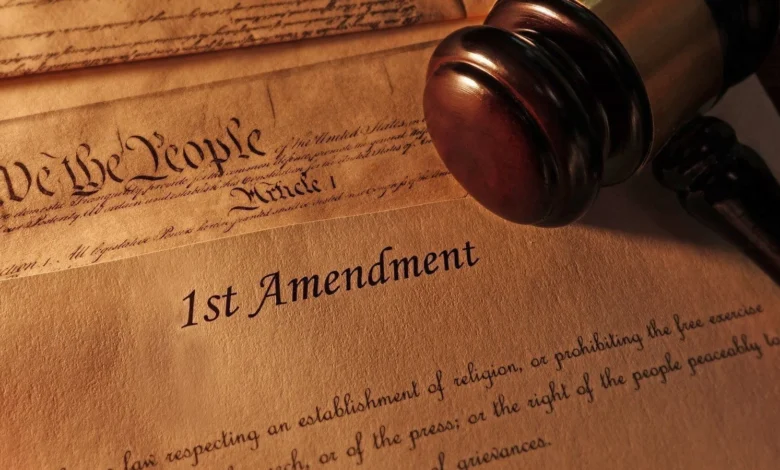
The 1st Amendment stands as the cornerstone of American democracy, serving as an impenetrable shield that protects your freedom in ways that many citizens take for granted. Ratified on December 15, 1791, this fundamental piece of legislation represents far more than mere words on parchment—it embodies the revolutionary spirit that birthed a nation founded on individual liberty and democratic principles.
When the founding fathers crafted this constitutional amendment, they understood that true freedom required explicit protection from governmental overreach. The1st Amendment protections emerged from their direct experience with British tyranny, where colonists faced severe restrictions on speech, religious practice, and peaceful assembly. This historical context shaped their determination to create a legal framework that would prevent such oppression from ever taking root on American soil.
The text of the1st Amendmentt reads: “Congress shall make no law respecting an establishment of religion, or prohibiting the free exercise thereof; or abridging the freedom of speech, or of the press; or the right of the people peaceably to assemble, and to petition the Government for a redress of grievances.” These forty-five words contain within them the blueprint for a free society, establishing constitutional rights that have withstood the test of time and continue to evolve through judicial interpretation.
Understanding how the First Amendment protects your freedom requires examining each of its components individually while recognizing how they work together to create a comprehensive system of civil liberties. From the moment you wake up and read the news to expressing your political opinions or practicing your faith, these freedom of speech protections touch virtually every aspect of daily life in America.
1. Freedom of Speech: Your Right to Express Ideas Without Fear
The Bedrock of Democratic Discourse
Freedom of speech represents perhaps the most recognizable aspect of First Amendment protections, yet its scope extends far beyond casual conversation. This fundamental right encompasses not only spoken words but also written expression, symbolic speech, and even certain forms of conduct that communicate ideas. The constitutional right to free expression serves as the foundation upon which all other democratic processes rest.
The Supreme Court has consistently reinforced that free speech rights apply to popular and unpopular opinions alike. The landmark case of Texas v. Johnson (1989) exemplified this principle when the Court ruled that flag burning constitutes protected symbolic speech, despite the controversial nature of such expression. This decision underscores how the First Amendment safeguards even offensive or disagreeable speech, recognizing that suppressing unpopular viewpoints ultimately weakens democracy itself.
Modern Challenges to Speech Protection
In today’s digital age, freedom of speech faces new challenges that the founding fathers could never have anticipated. Social media platforms, online forums, and digital communication have created unprecedented opportunities for expression while simultaneously raising questions about the limits of free speech rights. The First Amendment protects your freedom to express opinions online, though private companies retain the authority to establish their own content policies.
Civil liberties advocates continue to monitor developments in digital speech regulation, ensuring that technological advancement doesn’t erode constitutional protections. The balance between preventing harmful content and preserving open dialogue remains an ongoing challenge that requires careful consideration of First Amendment principles in the digital realm.
2. Religious Freedom: Practicing Faith Without Government Interference
The Establishment and Free Exercise Clauses
The First Amendment provides dual protection for religious freedom through both the Establishment Clause and the Free Exercise Clause. These complementary provisions ensure that government cannot favor any particular religion while simultaneously protecting individuals’ rights to practice their chosen faith. This constitutional protection creates what Thomas Jefferson famously described as a “wall of separation between church and state.”
The Establishment Clause prevents government from creating official state religions or showing preference for particular faiths, while the Free Exercise Clause protects individuals’ rights to worship, observe religious customs, and live according to their spiritual beliefs. Together, these provisions demonstrate how the First Amendment protects your freedom to choose your own spiritual path without governmental coercion or interference.
Balancing Religious Liberty and Civil Order
Religious freedom under the First Amendment is not absolute, and courts must sometimes balance free exercise rights against other legitimate governmental interests. The Supreme Court’s decision in Employment Division v. Smith (1990) established that generally applicable laws that happen to burden religious practice do not violate the First Amendment, provided they are religiously neutral and applied equally to all citizens.
However, constitutional protections for religious practice remain robust, particularly when government specifically targets religious behavior or shows hostility toward faith-based practices. The Religious Freedom Restoration Act further strengthened these protections by requiring strict scrutiny when government actions substantially burden religious exercise, demonstrating ongoing commitment to First Amendment principles.
3. Freedom of the Press: Ensuring Independent Journalism
The Fourth Estate’s Constitutional Foundation
Freedom of the press serves as democracy’s watchdog, providing citizens with the information necessary to make informed decisions about their government and society. This First Amendment protection recognizes that independent journalism plays an essential role in maintaining governmental accountability and exposing corruption, abuse of power, and other threats to democratic governance.
The constitutional right to press freedom extends beyond traditional newspapers to include magazines, broadcast media, online publications, and individual journalists working across various platforms. This broad interpretation ensures that press freedom evolves with technological change while maintaining its core function of keeping citizens informed about matters of public importance.
Protecting Journalistic Independence
Press freedom under the First Amendment includes protection from prior restraint, meaning government generally cannot prevent publication of information before it occurs. The landmark Pentagon Papers case (New York Times Co. v. United States, 1971) established that government bears an extremely heavy burden when attempting to prevent publication, even of classified information that might embarrass officials or reveal government mistakes.
Modern challenges to freedom of the press include attempts to compel journalists to reveal confidential sources, government surveillance of reporters, and efforts to limit press access to public information. Civil liberties organizations continue advocating for robust press freedom, recognizing that independent journalism remains essential to democratic accountability and constitutional governance.
4. Right to Peaceful Assembly: Gathering for Common Causes
Collective Expression and Democratic Participation
The right to peaceful assembly recognizes that individual free speech becomes more powerful when citizens gather collectively to express shared viewpoints and advocate for common causes. This 1st Amendment protection encompasses peaceful protests, rallies, demonstrations, marches, and other forms of group expression that allow citizens to amplify their voices and participate meaningfully in democratic processes.
Constitutional protections for assembly extend to public forums such as parks, sidewalks, and government buildings, where citizens have traditionally gathered to express political opinions and engage in civic discourse. The 1st Amendment protects your freedom to join with others in peaceful expression, provided such gatherings do not threaten public safety or significantly disrupt legitimate governmental functions.
Balancing Assembly Rights with Public Order
While the right to assembly enjoys strong constitutional protection, it must be balanced against legitimate governmental interests in maintaining public order and safety. Time, place, and manner restrictions may be imposed on assemblies, provided such regulations are content-neutral, narrowly tailored to serve important governmental interests, and leave ample alternative channels for expression.
Civil liberties advocates monitor enforcement of assembly regulations to ensure that restrictions are applied fairly and do not discriminate against particular viewpoints or groups. The First Amendment requires that any limitations on peaceful assembly be justified by compelling governmental interests and implemented through the least restrictive means possible.
5. Petition for Redress of Grievances: Seeking Government Accountability
Direct Communication with Elected Officials
The right to petition government for redress of grievances provides citizens with a direct avenue for communicating concerns, complaints, and requests to their elected representatives and government agencies. This First Amendment protection recognizes that effective democracy requires ongoing communication between citizens and their government, ensuring that public officials remain responsive to constituent needs and concerns.
Constitutional rights to petition encompass various forms of communication including letters, emails, phone calls, formal petitions, lobbying efforts, and requests for government action or policy changes. This freedom extends to both individual and collective petitioning, allowing citizens to work together in pursuing governmental responses to shared concerns.
Modern Applications of Petition Rights
Contemporary applications of petition rights include online petitions, social media campaigns directed at government officials, formal requests for government documents under freedom of information laws, and organized lobbying efforts by citizen groups. The First Amendment protects your freedom to seek governmental accountability through these various channels, ensuring that democratic participation extends beyond periodic elections.
Civil liberties protections for petitioning also include the right to request judicial review of government actions, file lawsuits challenging unconstitutional policies, and seek legal remedies when government violates individual rights. This comprehensive approach to petition rights ensures that citizens have multiple avenues for addressing governmental wrongdoing and seeking appropriate relief.
6. Academic Freedom: Protecting Educational Discourse
Intellectual Freedom in Educational Settings
Academic freedom represents a specialized application of First Amendment protections within educational contexts, recognizing that robust intellectual inquiry requires protection from political pressure and ideological conformity. This principle ensures that teachers, professors, students, and researchers can pursue knowledge, engage in scholarly debate, and express academic conclusions without fear of retaliation or censorship.
Constitutional protections for academic expression extend to curriculum decisions, research topics, classroom discussions, and scholarly publications. The First Amendment protects your freedom to engage in intellectual exploration and express educational viewpoints, even when such ideas challenge conventional wisdom or popular beliefs within academic communities.
Balancing Educational Authority and Free Expression
Academic freedom must be balanced against legitimate educational interests in maintaining appropriate learning environments and ensuring that instruction meets established standards. Courts have recognized that educational institutions possess some authority to direct curriculum and maintain discipline, while simultaneously protecting free speech rights of students and faculty within educational settings.
Civil liberties in education require ongoing vigilance to prevent political interference in academic decision-making and protect constitutional rights of educational community members. The First Amendment ensures that schools and universities remain places where diverse ideas can be explored and debated freely, contributing to intellectual growth and democratic participation.
7. Symbolic Speech: Non-Verbal Expression Protection
Beyond Words: Actions as Expression
Symbolic speech encompasses non-verbal actions that communicate ideas or messages, receiving First Amendment protection when such conduct is intended to convey particularized messages that would be understood by reasonable observers. This expansion of free speech rights recognizes that meaningful expression often transcends spoken or written words, including actions, symbols, and conduct that communicate political, social, or cultural messages.
Constitutional protections for symbolic expression have covered diverse activities including flag displays, armbands, artistic performances, and peaceful protest methods. The First Amendment protects your freedom to communicate through symbols, gestures, and conduct that express viewpoints or convey messages to others, provided such expression does not violate generally applicable laws or threaten public safety.
Defining the Boundaries of Protected Symbolic Expression
Courts apply specific tests to determine whether symbolic conduct qualifies for First Amendment protection, examining factors such as the intent to communicate, the likelihood that observers would understand the message, and the governmental interest in regulating the particular conduct. Symbolic speech receives less protection than pure speech when conduct elements create genuine concerns about public order or safety.
Civil liberties advocates continue working to ensure that symbolic speech protections remain robust while acknowledging legitimate governmental interests in regulating conduct. The balance between freedom of expression and public order requires careful analysis of each situation, ensuring that constitutional rights are preserved while maintaining community safety and welfare.
Conclusion
The 1st Amendment protects your freedom through these seven interconnected mechanisms that work together to create a comprehensive framework for democratic participation and individual liberty. From freedom of speech and religious freedom to press freedom and the right to assembly, these constitutional protections ensure that American democracy remains vibrant and responsive to citizen needs.
Understanding and exercising these First Amendment rights requires active participation from all citizens who value civil liberties and democratic governance. As society evolves and new challenges emerge, the principles embodied in these constitutional protections must be continually defended and applied to contemporary circumstances.
The ongoing relevance of First Amendment protections demonstrates the wisdom of the founding fathers in creating a framework flexible enough to address changing times while maintaining core commitments to individual freedom and democratic accountability. These constitutional rights remain as essential today as they were over two centuries ago, requiring vigilant protection and informed exercise by citizens committed to preserving American liberty.
Read More: Trump’s Historic 2nd UK Visit Amazing Royal Welcome 2025







